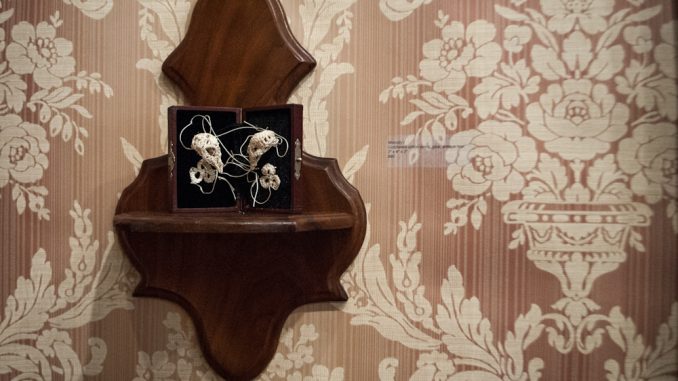
Damask wallpaper sagged off the walls in uneven swathes. Tiny, bone-white creatures watched from their black velvet cages. Old-fashioned music filled the space, reminiscent of silent films and Victorian parlors.
The Art Dept., a gallery in Fishtown, was transformed into this dark, oppressive space for Caitlin McCormack and Casey Murphy’s group show, Ex Silento. Running through the end of June, the installation is about “ghosts of the grandeur that used to be,” according to exhibits director Kate Glasheen.
Beyond the gallery’s glass window facing Berks Street, McCormack’s fiber skeletons, created from crocheted thread and stiffened with glue, hung beside Murphy’s mixed media works, like books adorned with geometrical thread or antique garments burned and altered.
During the show’s opening reception on June 5, visitors were plentiful, moving through the exhibit quietly, often unable to discern which artist created each piece.
“I hadn’t seen [Murphy’s] work in a larger space before,” McCormack said. “I thought the colors and the tone of her work would really compliment what I was going for.”
For Glasheen, the moment McCormack and Murphy showed up with their work to start the installation, everything seemed to fall into place.
“We had some supplies to work with,” Glasheen said. “Caitlin [McCormack] had brought the old wallpaper, some drapery, and from there, it was a fluid, evolving process. We were digging things up as we went.”
One discovery in particular seemed to be a perfect fit, according to McCormack: “pieces of the building before it had been modernized.”
Immediately, McCormack brought some of the old beams downstairs into the gallery space. For the show, the dark, crooked planks rested in a pile against the wall. Two pairs of antique children’s shoes, a work of Murphy’s, found a home atop the beams.
“The space kind of spoke to us,” McCormack said. “It dictated how we arranged the show.”
The Art Dept.’s owner, Emily Harris, went a step further to create the desired atmosphere of ruined Victorian grandeur. Harris invited Riley MacLean, a tintype photographer from North Carolina, to take shots of the gallery’s guests.
The photographer said his work is “a good fit” for what the show was trying to accomplish, citing his interest in “making portraits” and “collecting interesting people.”
MacLean took tintypes of visitors throughout the night, bringing the grayscale pieces into the gallery space to line up along a table. Across the room hung some of Murphy’s antique photos, more sepia-toned than MacLean’s shining silver and black pieces.
“[Murphy] convinced me she knew everybody in those antique photos, and she doesn’t know any of them,” said Shannon Rafferty, 23, of Northeast Philadelphia. “And that’s the point, right? It’s actually phenomenal.”
For McCormack, the show was meant to “communicate a sense of stillness that you would have at the end of your life, all of your culminated experiences presenting themselves to you at once.”
The show made McCormack think about aging and something that “transcends melancholy.” That emotion was intensified when the artist realized the day of the show’s opening was her grandparents’ anniversary.
“So much of my work is about my grandparents,” McCormack said, referring to her art’s synthesis of her late grandparents. Her grandmother was gifted at crocheting, and her grandfather woodworked small animals. McCormack’s work, the tiny, crocheted skeletons of creatures, encompassed them both.
“It got closer to home,” McCormack said. “When you conceptualize an exhibit, you do distant yourself from the root of what your work is about. There was a pang of remembrance.”
For Glasheen, the ultimate feeling of the show should reflect that loss and subsequent remembrance – McCormack’s loss of her grandparents, and the personal emptiness in each individual viewer.
“There should be a feeling that this used to be something,” Glasheen said. “Something substantial and great. Maybe it was a family’s home, but now there’s just bones and dust and peeling wallpaper.”
Victoria Mier can be reached at victoria.mier@temple.edu



Be the first to comment